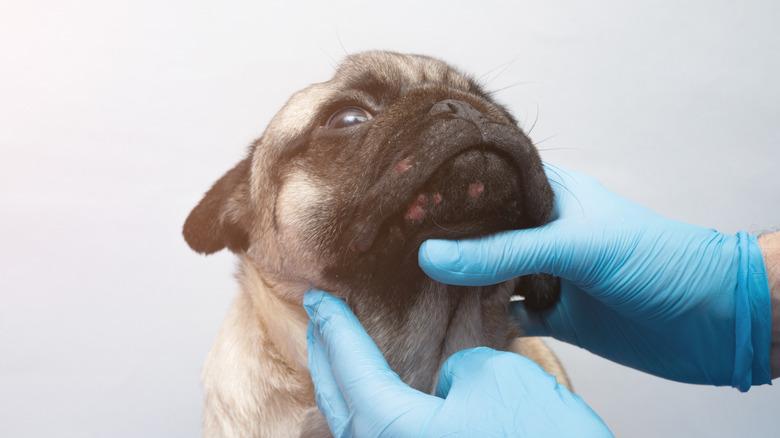Symptoms To Look For If Your Dog Has Allergies
Seeing your pet suffering can feel very frustrating. Dogs, unlike humans, can't verbally express what's causing their discomfort, which makes the entire process of figuring out the reasons for their distress all the more challenging.
When it comes to allergies in dogs, there's an additional layer of confusion because of the different types of allergies out there, most of which manifest with similar symptoms, according to the American Kennel Club. An allergy is best defined as an overactive response by your dog's immune system to a foreign substance; the increased level of histamines released by your dog's immune system to combat the allergen becomes the source of your dog's discomfort (via Daily Paws).
Classification of allergies varies depending on factors like the type of allergen — whether it's food or flea/insect bites, how the allergen enters the body — respiratory means, via the skin, ingestion, etc., or if the allergy was inherited, per VCA Animal Hospitals. Allergies in dogs are quite common, with most manifesting when your puppy is over 6 months old. While you might be tempted to figure out what's triggering your pet's allergies, you may want to start with understanding the symptoms first.
These are the most common symptoms to look out for
The most common manifestation of an allergy is skin problems but this is not the only symptom to watch out for; there are also symptoms related to your dog's digestive and respiratory systems, according to Daily Paws.
The common symptoms to look out for include itchy skin and or inflamed skin, itchy ears or eyes, skin rashes, upset tummy and puking, incessant licking, sneezing, and ear infections that won't heal up (via American Kennel Club). You may also want to watch for persistent coughs and fur loss.
When it comes to airborne allergies, the most common symptom you'd be dealing with is itching. Your dog's paws, belly, ears, and legs could all become hot zones and prolonged itching can lead to other skin conditions, reports the Merck Manuel. Similar symptoms can be observed with food allergies, but there could be a difference in the severity of the scratching.
Diagnosing your dog's allergy
Noticing symptoms is half the battle. Diagnosis of your dog's allergy is a complicated process of trial and elimination and would involve you working together with professionals.
If your vet suspects a food allergy, the course to follow would likely involve an elimination diet — a diet consisting of one new type of protein to be given to your dog for a certain period of time, after which old foods are slowly added back to the diet (via Daily Paws). Treating your dog's food allergies involves an intentional and careful approach.
Intradermal skin testing is another form of allergy testing that specialists conduct in order to find out the potential allergens in the environment that are causing discomfort to your dog, according to Arkansas Veterinary Emergency & Specialists. This essentially involves injecting allergens into the "subcutaneous layer" of your dog's skin and observing for reactions. Your pet is usually given a sedative before the testing begins. After the completion of the process, an allergy serum will be developed that would be very specific to your dog's needs. Testing your dog's blood is another way to develop such an allergy serum, although the results may not be as effective.
Whatever course of action you decide to take, the important thing to remember is to be observant of your beloved pet when they are in distress, so you can better assess when and how your vet can step in and help.


